Salmon Sushi Bake is a simple but delicious Asian fusion casserole that consists of flaky salmon in a creamy sauce on top of warm rice. It lets sushi novices enjoy without having to stress over rolling the rice. Made with easy to find ingredients, it's a great sharing dish that's on the table in 20 minutes (excluding the time to cook the rice!)
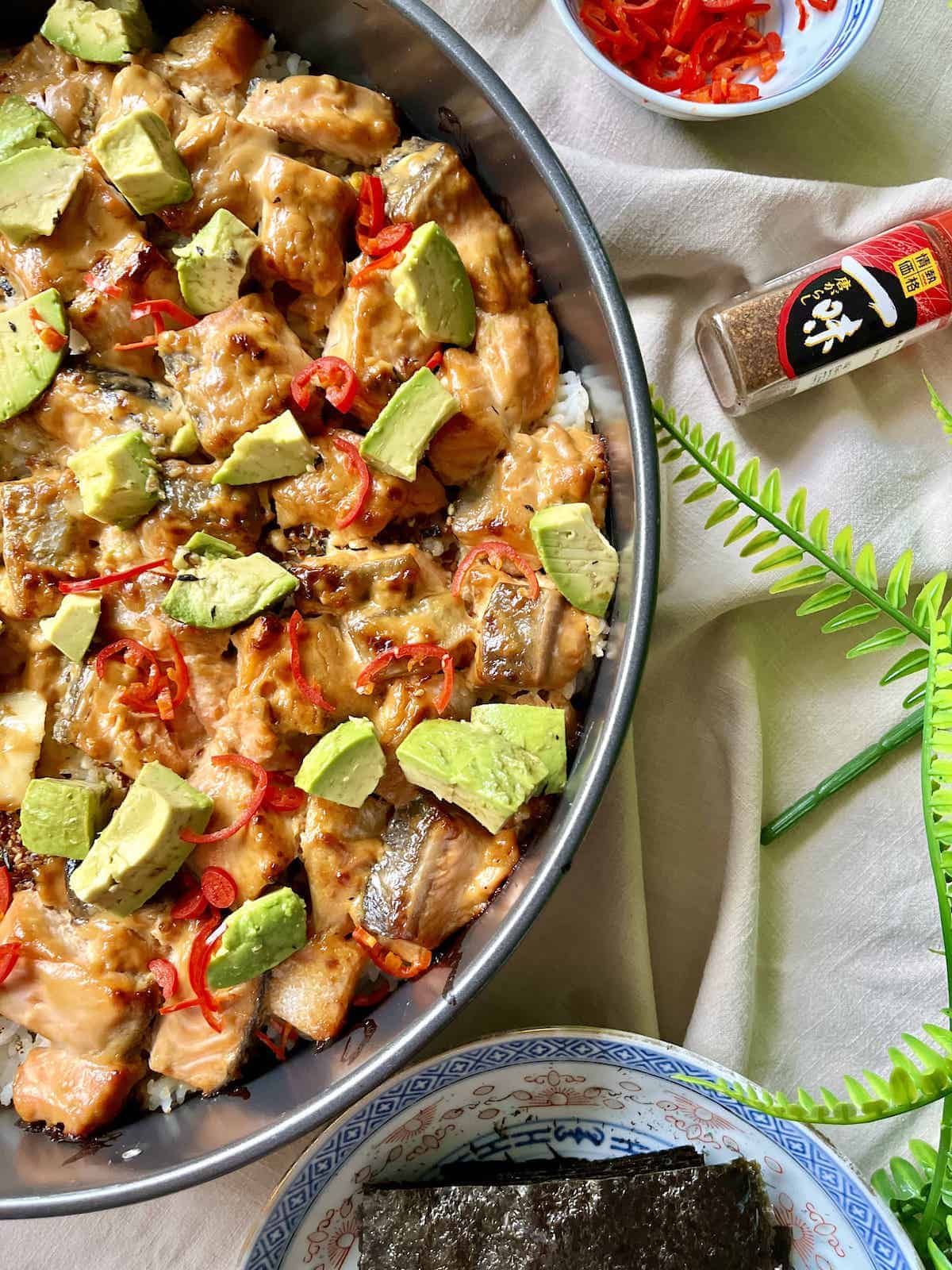
Jump to:
⭐ Why This Recipe is a Star
- Quick, simple to make but scrumptious: You don't need to make a special trip to the Asian grocery store for this easy sushi bake recipe as the ingredients are readily available (unless you want to put ikura, ebiko or tobiko on top!) Plus, it's a great way to use up leftover Japanese rice!
- Versatile: I've made the basic sushi casserole recipe non-spicy, to cater for all tastes. However, you can easily switch it up by using a spicy mayo such as kimchi mayo, gochujang mayo, sriracha mayo or even sambal mayo (instead of the plain Kewpie I used.) Or follow my recipe, then sprinkle shichimi on it liberally after baking!
- Crowd pleaser: It's a fun party for a party, especially if you serve it with seaweed sheets so that people can wrap their own sushi rolls. Goes really well with some Asian pickles on top!
What is Sushi Bake?
Also known as deconstructed sushi roll or baked sushi casserole, it is is essentially a Pan Sushi or Spicy Salmon Sushi Roll that has been warmed up in the oven, and has melted creamy cheese oozing all over it!
🥘 Ingredients
You'll need these simple ingredients for the rice:
- sushi rice: if you can't get Japanese Koshihikari short grain rice, you can use sushi rice substitutes such as risotto rice. I sometimes add a piece of dried kelp when cooking the rice, for extra umami, but it's totally optional. Honestly, you might not even be able to tell, unless you have very delicate taste buds!
- Sushi seasoning: to save money, you can make your own sushi vinegar using white rice vinegar, white sugar and salt (exact quantities provided in the recipe card below.)
- Furikake: this Japanese seasoning can be bought at Trader Joes, Whole Foods, Asian grocery stores and Japanese markets. Or make your own by mixing lightly toasted sesame seeds with cut up pieces of seaweed and dried seafood. It makes even a bowl of plain white rice delicious!
For the salmon mixture, you'll need:
- Fresh salmon: I cut mine into 1 by 1.5 inch pieces. Some people may prefer them smaller, in which case, they'll cook up faster. Frozen salmon works but it'll have a lot of water around it after thawing, so pay dry with paper towels before covering in the sauce. Canned crab, imitation crab meat, real crab meat and canned tuna are all good substitutes.
- Mayonnaise: I actually use a lot less mayo than the usual recipe, but if you look at the step-by-step photos below, it's more than enough. Of course, feel free to squeeze more onto the baked rice later, if you want more! My go-to is Japanese Kewpie Mayonnaise as it is just so much tastier than regular mayonnaise! If you can't get Japanese Mayo, DIY by combining ½-1 teaspoon of white sugar with regular mayo. (Some people add chicken stock powder too.) I have not tested the recipe with sour cream or Greek yoghurt. (If you substitute, you'd probably need more sugar.)
- Cream cheese: This makes the salmon taste richer and gives it a bit of a charred top when it melts all over the rice. Use your hands to mix it into the salmon- if not, you'll need to soften the cream cheese by taking it out of the fridge 5-10 minutes before mixing the sauce with a fork. (Otherwise, the sauce will be lumpy.)
- Vinegar: Adding some acid helps to keep the flavor bright, and makes sure the dish does not taste too heavy. If you have pickled cucumbers or pickled chilies sitting in the fridge, use that brine instead of vinegar!
- Soy sauce: remember it's light soy sauce we want and not dark soy or sweet soy. (Although, to be honest, those flavors would probably go well too!)
- White sugar: a little bit of sweetness really helps to make the flavors shine but you can skip this if you used shop-bought sushi seasoning (it is sweetener than my homemade version.)
- Sesame oil: this is actually optional. Skip it if you want a purer Japanese flavor. (Sesame oil is more of a Korean Gimbap/ Korean sushi ingredient but I like the aroma, so I've included it.)
Suggested toppings:
- Avocado: I highly recommend topping with cut up or sliced avocado. Refrigerate till you want to assemble the sushi bake, to get a nice contrast of cold avocado and warm rice!
- Green onions: sliced scallions- or freshly sliced jalapenos- are a good way to introduce freshness to lift the creamy mayo sauce.
- Nori Sheets, optional: to make it a "handroll party", cut large toasted seaweed sheets or 1 of its substitutes into quarters, and use them to roll the baked salmon and rice in. You can use Japanese or Korean seaweed (roasted gim.)
📖 Variations & Substitutes
- Spicy Salmon baked sushi: If you like hot foods, switch out the mayo for sriracha mayo, hot sauce, kimchi aioli, sambal spicy aioli or Korean gochujang aioli. If you want to cater to people who can't take the heat, use regular mayo but serve with shichimi, gochugaru flakes or sliced chilies at the side for people to add their own.
- Oozing cheese: add grated cheese before baking.
- Deconstructed California Rolls: Instead of salmon, use imitation crab and add Japanese salmon roe (ikura), fish roe (tobiko) or shrimp roe (ebiko) after the dish comes out of the oven. (We don't want to cook the roe- it'll still be edible but it'll lose its oomph.)
- 2-in-1: you can even use 2 or more different toppings, such as canned tuna on 1 side, this cheesy salmon on the 2nd and teriyaki salmon on the 3rd.
🔪 Step-by-Step Instructions
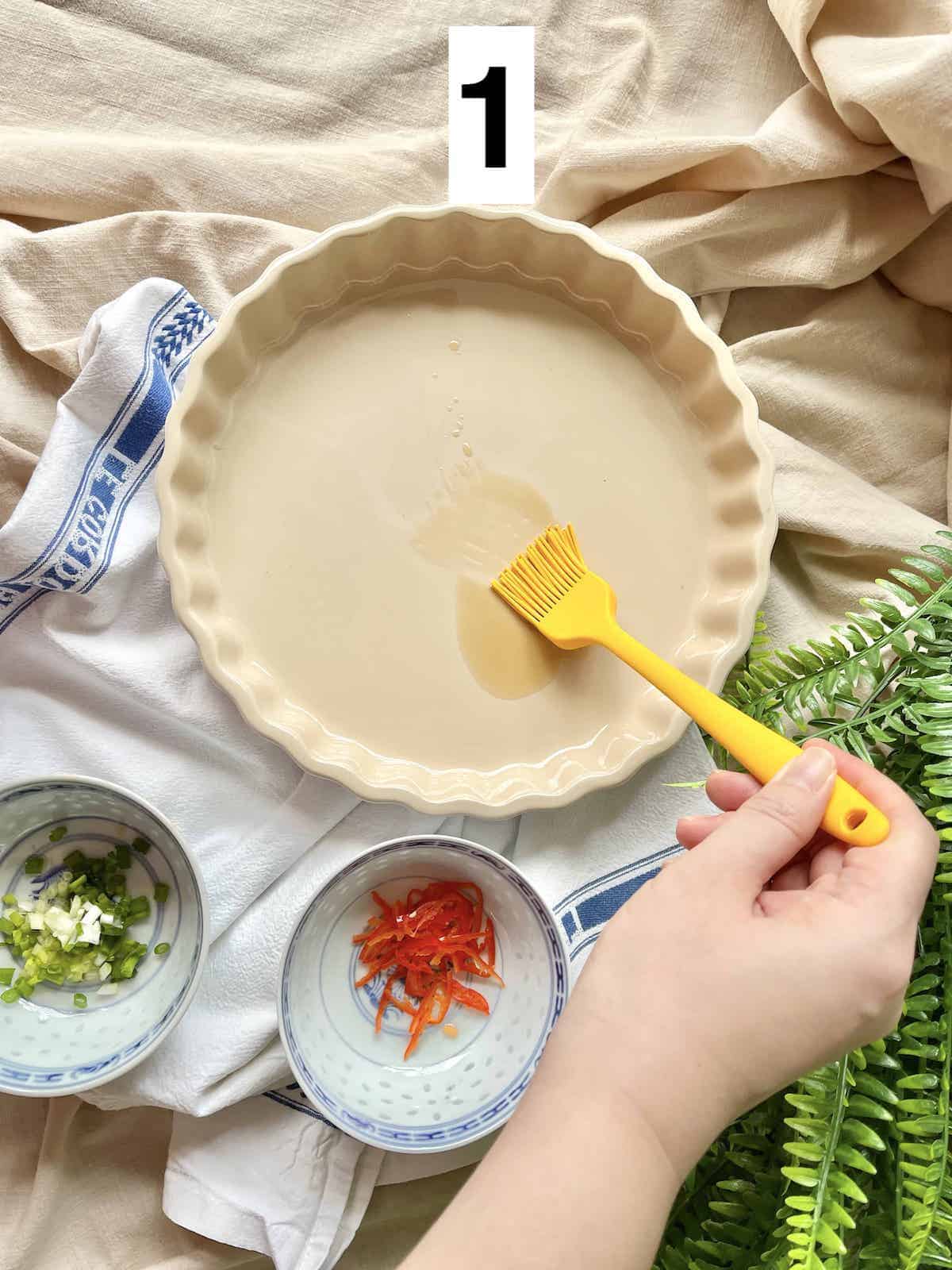
- Optional: coat the baking dish with ½ Tablespoon of sesame oil for a more savory flavor.
Tip: I find a 10 inch dish works best. When I used a 12 inch dish, there wasn't even rice or salmon to go round. You would need about 1.5x the rice and 2x the amount of salmon.
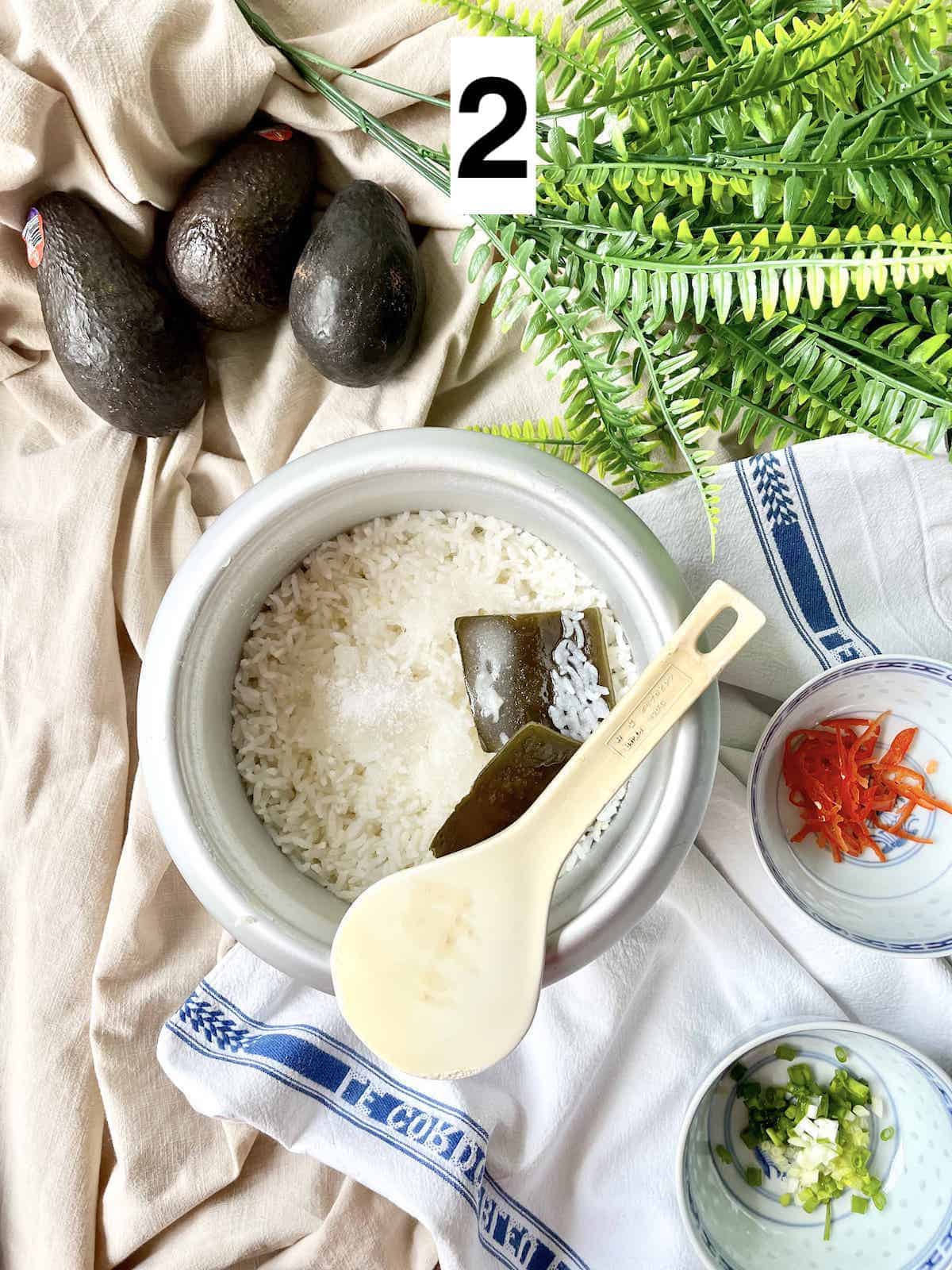
2. Cook the sushi rice as per normal. (Click through for detailed instructions.) I soak mine before cooking in a rice cooker, with a piece of dried kelp for a more savory flavor.
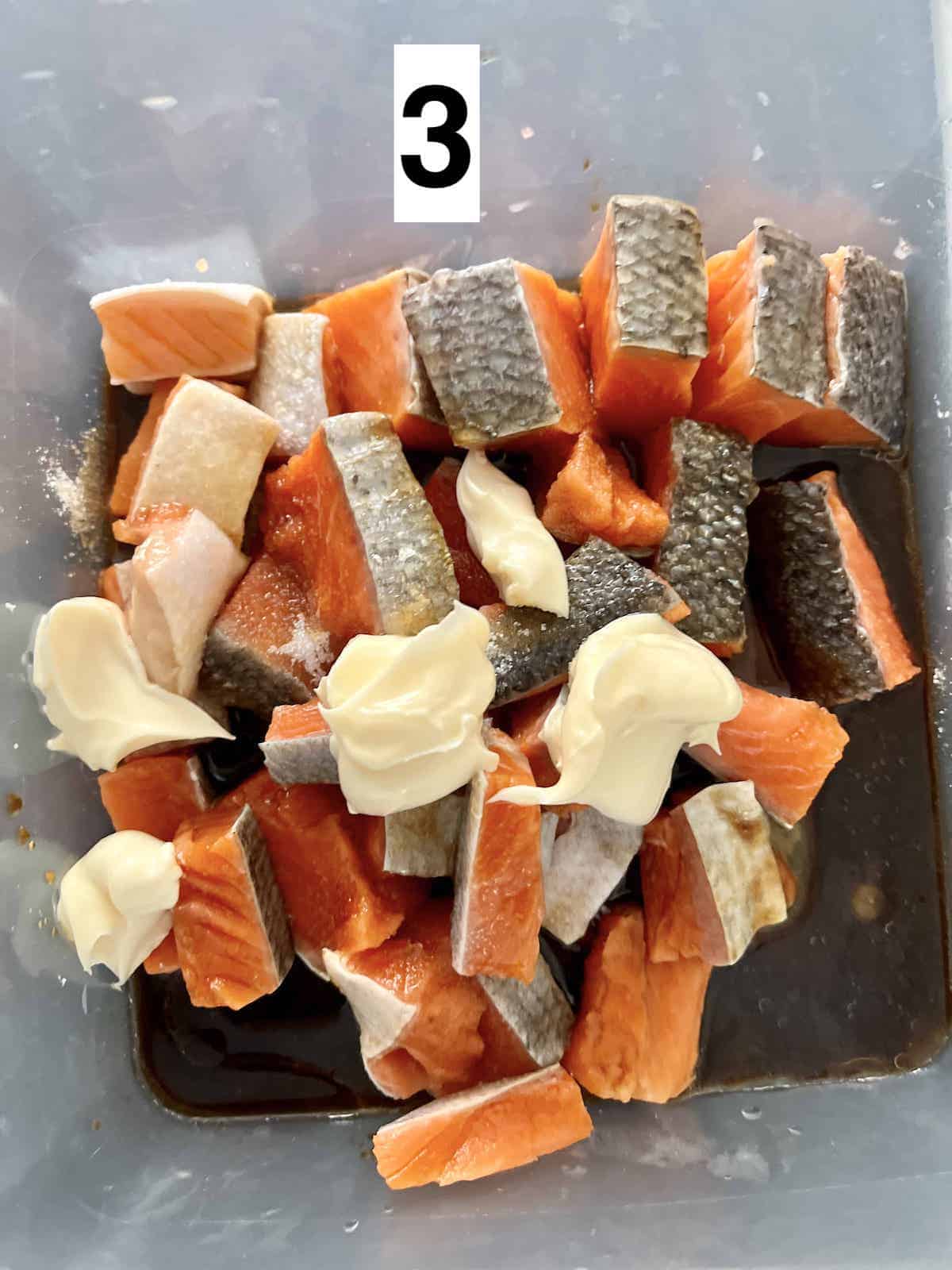
3a. 5-10 minutes before the rice is done, take the salmon out of the fridge. (We don't want to cook it fridge cold or the texture won't be great. But not more than 15 minutes for food safety's sake!)
3b. Cut into 1 by 1.5 inch pieces, then mix well with the mayonnaise, cream cheese, soy sauce, vinegar/ pickle brine, sesame oil and sugar.
Put aside whilst we season the rice.
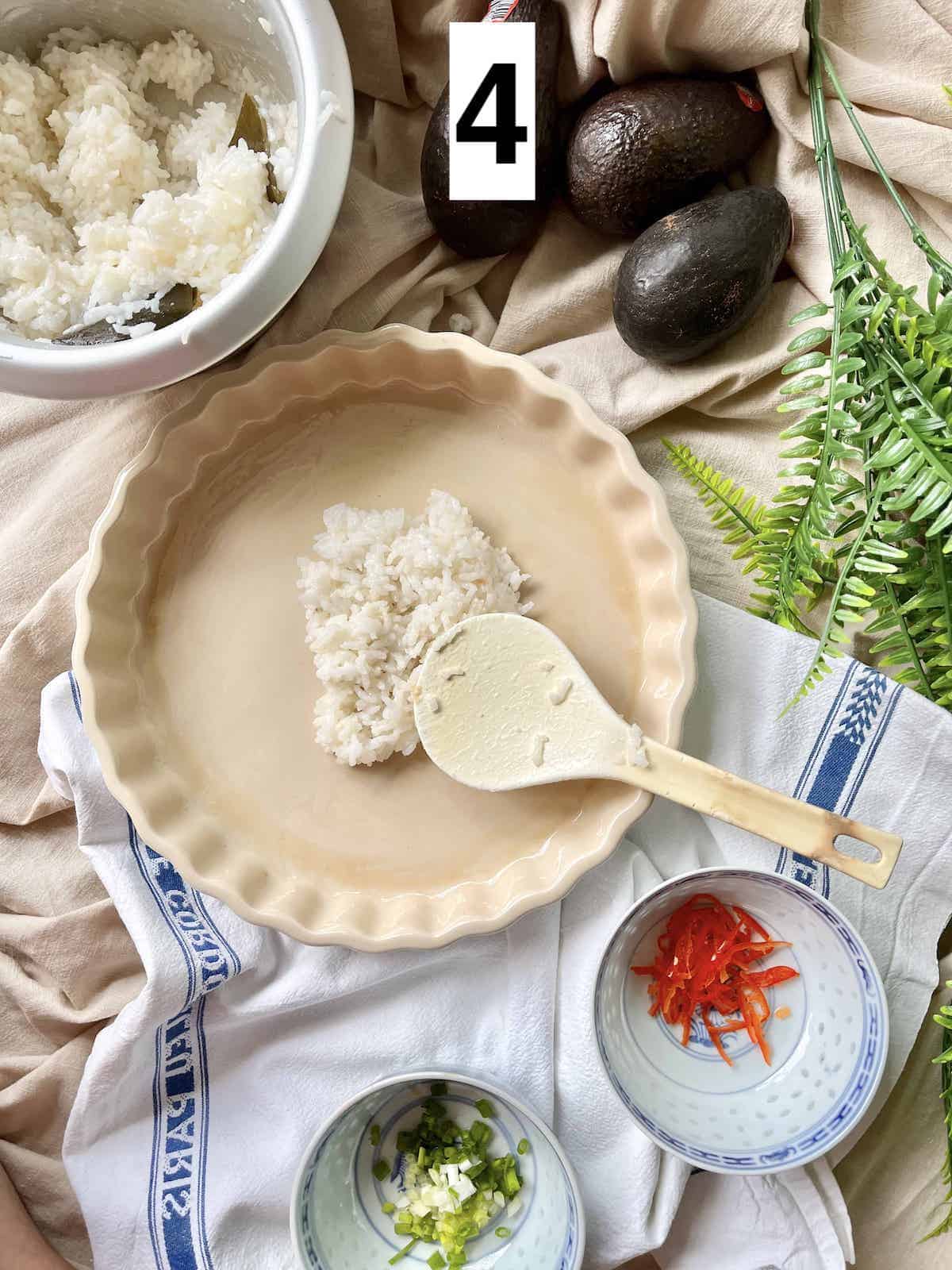
4a. Once the short-grain rice has cooked, mix in the seasoned sushi vinegar (vinegar combined with sugar and salt.)
4b. Spread the seasoned rice on the casserole dish till it's completely filled.
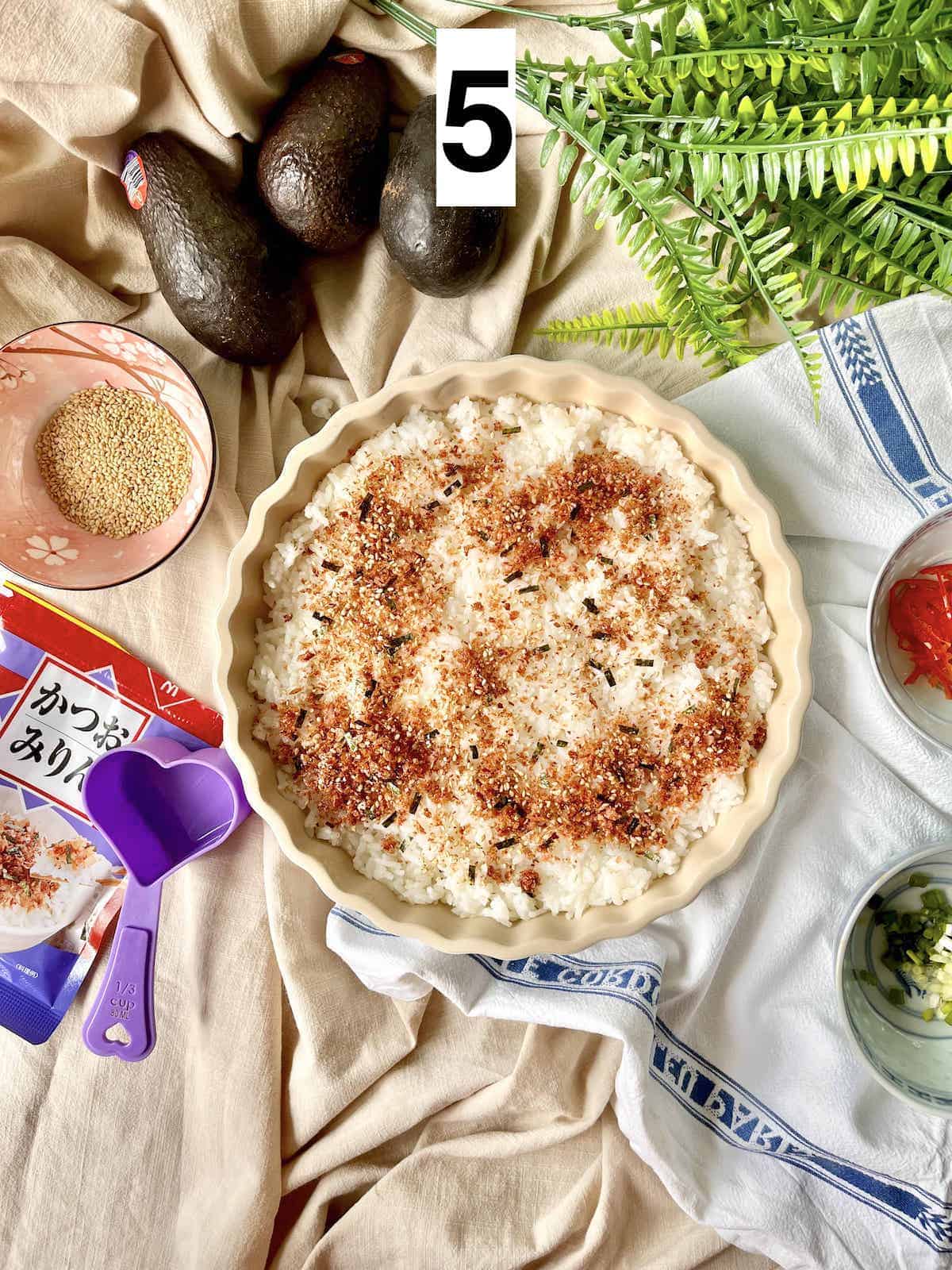
5. Add ½ of the Furikake seasoning evenly all over tangy sushi rice- be generous as it gives the dish its flavor.
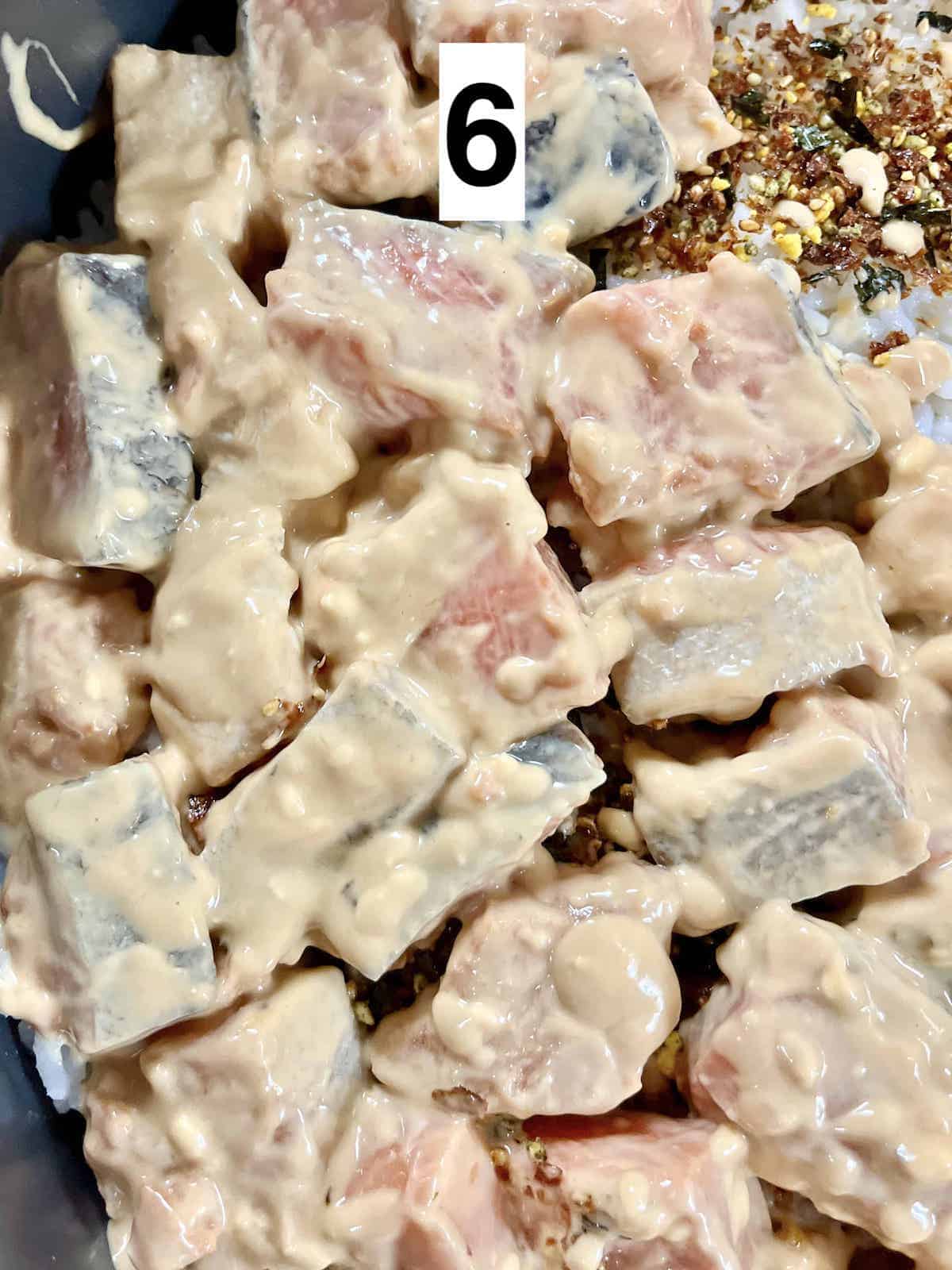
6a. Spread the salmon on top of the rice.
6b. Bake in a pre-heated oven at 425F/ 218C/ 198C fan for about 12 minutes or till the salmon is cooked through but still flaky. (The cooking time will change depending on hot your oven runs or how big you cut the pieces.)
6c. Add the rest of the furikake- if you're using the fish roe, you may not need all the remaining furikake, so taste before you season.

7a. Whilst the dish is in the oven, cut the avocado and other toppings. Keep them in the fridge till you need them.
7b. Once the hot sushi in casserole form is out of the oven, top with the avocado slices, spring onions, sesame seeds, sliced chilies etc.
7c. Serve with seaweed and have fun!
🥡 How to Store
Leftovers should be refrigerated as soon as possible, kept in an airtight container. (Rice goes bad super fast and can give you bad food poisoning, so don't leave it at room temperature.)
You can reheat in a 325/ 162.8C oven for 10-15 minutes or microwave for 30 seconds, followed by 10 second increments till warmed through. Alternatively, I sometimes stir-fry it and make it into fried rice!
👩🏻🍳 Expert Tips
Tip #1: For the best non-mushy rice, when mixing the seasoning into the cooked rice, do not stir. What you want to do is to cut and fold the sauce into the rice with the rice spatula. Fanning in simultaneously helps too!
Tip #2: You can drizzle unagi sauce or teriyaki sauce on top!
Tip #3: You can place seaweed in muffin tins, followed by the rice and salmon before baking- the perfect seaweed snack for social media!
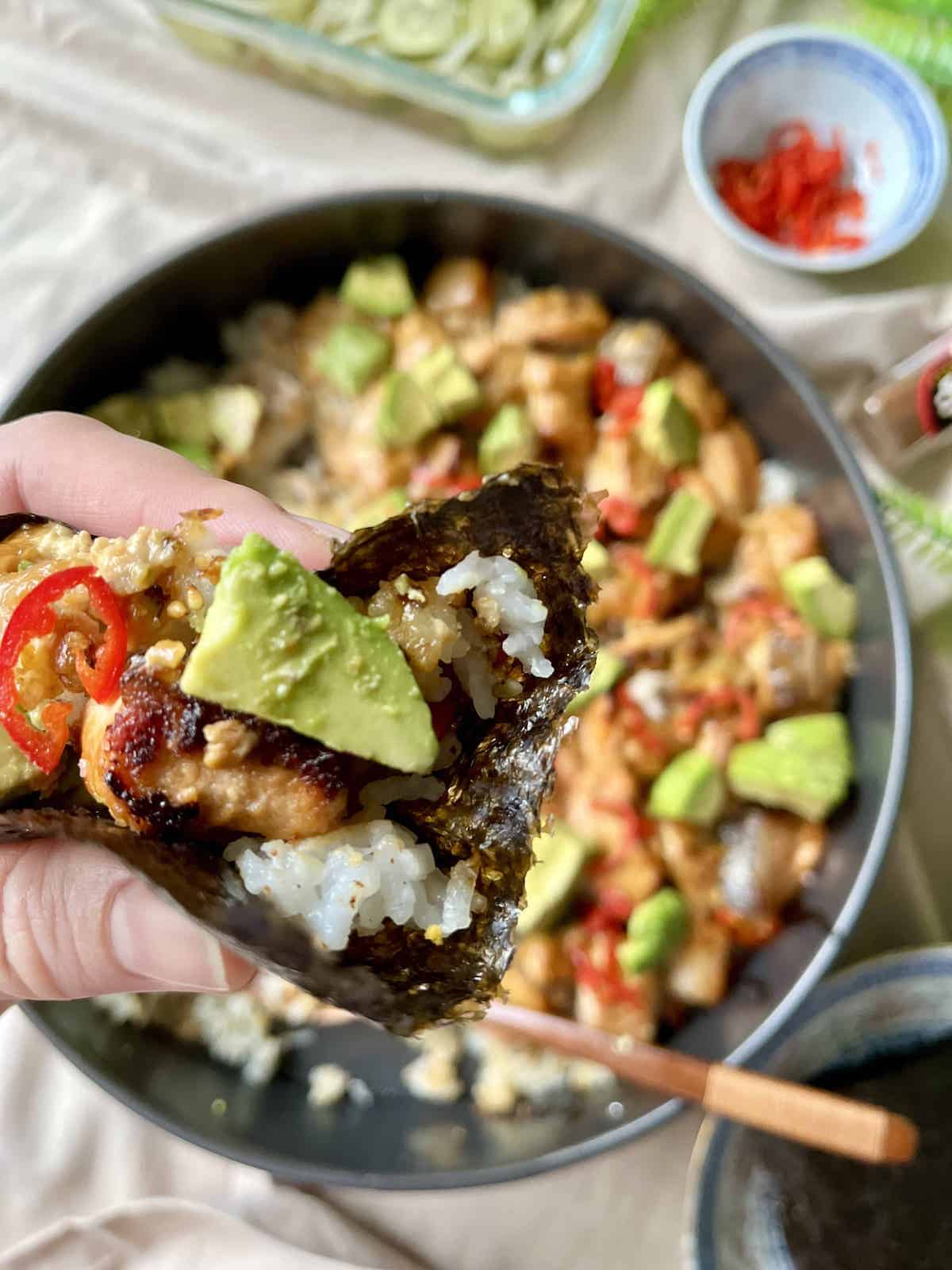
🥗 Suggested Accompanying Recipes
Enjoyed this homemade baked sushi with salmon recipe? Please leave a 5-star 🌟🌟🌟🌟🌟rating in the recipe card below! If you REALLY liked this salmon sushi bake recipe, please consider supporting it by buying me a matcha latte! 🙂 (No obligation though!) Thank you and have a great day!
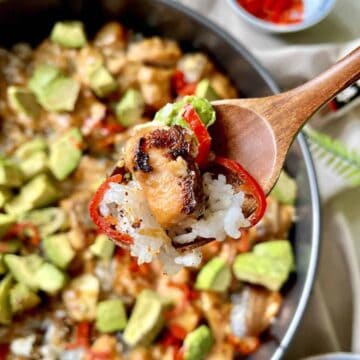
Salmon Sushi Bake Recipe
Equipment
- 1 10 inch casserole or baking dish
Ingredients
- 1 Tablespoon sesame oil
For the rice
- 1 Cup Japanese rice uncooked. Optional: add 1 piece of dried kelp when cooking
- ¼ Cup Rice Vinegar Substitute: you can mix the rice with sushi seasoning instead of the rice vinegar, white sugar and salt. It's a bit sweeter than my homemade version.
- 1 Tablespoon White Sugar
- 1 teaspoon Salt
For the salmon
- 1 lb salmon thawed from frozen works but pay dry. Cut into 1 by 1.5 inch pieces.
- 2 Tablespoons light soy sauce
- 2 Tablespoons Mayonnaise I like Kewpie. You can use spicy versions such as gochujang mayo, sambal mayo or kimchi mayo too.
- 2 Tablespoons cream cheese
- ½ Tablespoon rice vinegar Substitute: brine from pickled cucumbers
- 1½ teaspoon white sugar
Toppings
- 1 avocado Cut into slices or cubes
- ¼ Cup furikake You might want to add less if you decide to splurge on Japanese salmon or fish roe.
- 1 red chili thinly sliced, optional
Instructions
- Optional: coat the baking dish with ½ Tablespoon of sesame oil for a more savory, Korean taste.
- Cook the sushi rice as per normal. (Click through for detailed instructions.) I soak mine before cooking in a rice cooker, with a piece of dried kelp for a more savory flavor.
- 15-20 minutes before the rice is done, preheat the oven to 425F/ 218C/ 198C fan.
- 5-10 minutes before the rice is done cooking (takes about 40 minutes in a rice cooker), take the salmon out of the fridge. (We don't want to cook it fridge cold or the texture won't be great. But not more than 15 minutes for food safety's sake!) Cut into 1 by 1.5 inch pieces, then mix well with the mayonnaise, cream cheese, soy sauce, vinegar/ pickle brine, sesame oil and sugar. Put aside.
- Once the rice has cooked, mix the rice with the seasoned sushi vinegar (the vinegar combined with sugar and salt) by cutting and folding, not stirring.
- Spread the seasoned rice on the casserole dish till it's completely filled.
- Add ½ of the Furikake evenly and liberally all over rice, followed by the salmon.
- Bake in a pre-heated oven at 425F/ 218C/ 198C fan for about 12 minutes or till the salmon is cooked through but still flaky. (The cooking time will change depending on hot your oven runs or how big you cut the pieces.)
- Whilst the dish is in the oven, cut the avocado and other toppings. Keep them in the fridge till you need them. Once the hot casserole is out of the oven, top with the avocado slices, spring onions, sesame seeds, sliced chilies etc. Enjoy!
Notes
Note: the nutritional information is an estimate automatically calculated using the WPRM recipe maker and I am not responsible for its veracity.
Nutrition
If this easy Sushi Bake with Salmon recipe was helpful, maybe you'd like to sign up for my newsletter in which I send you more Asian recipes?

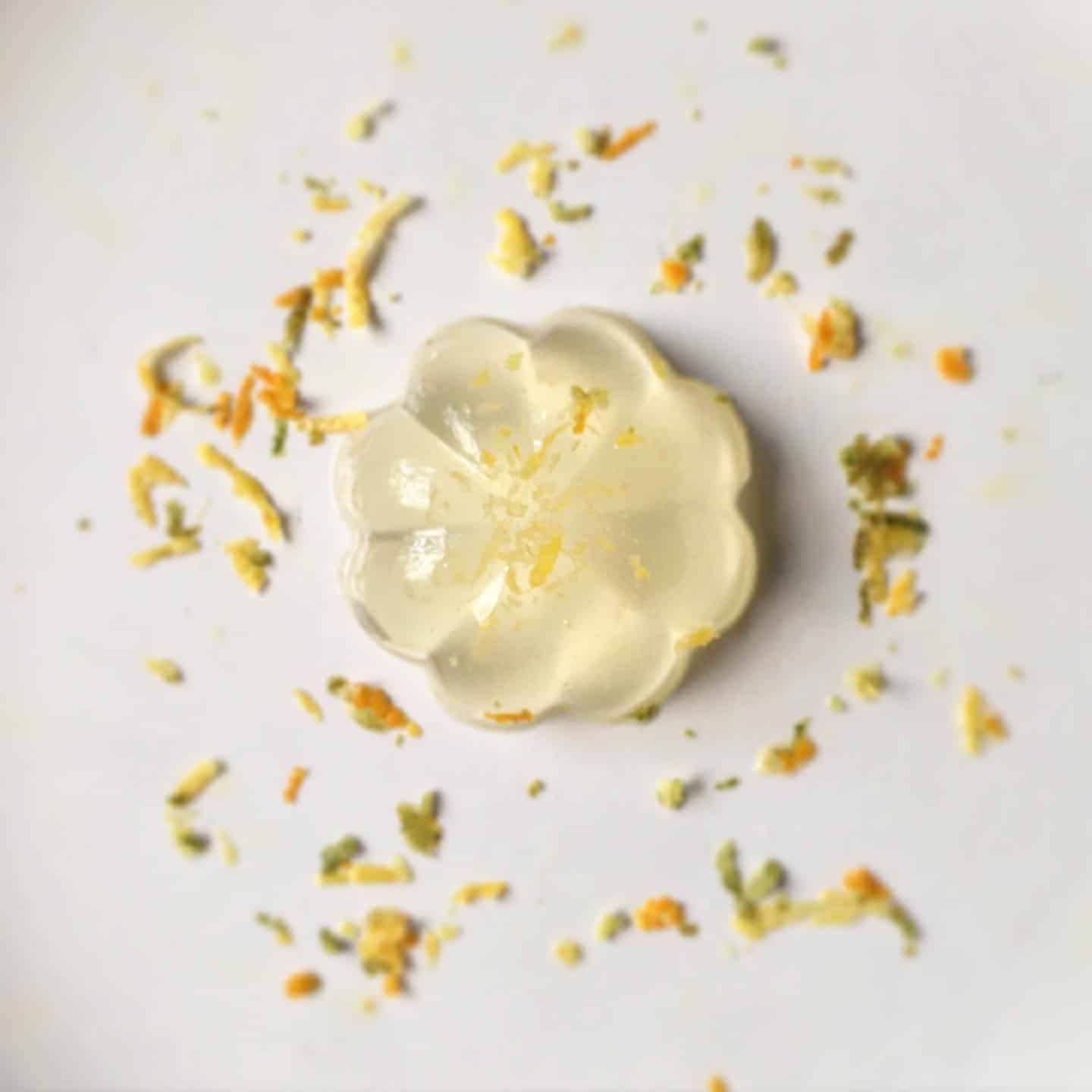
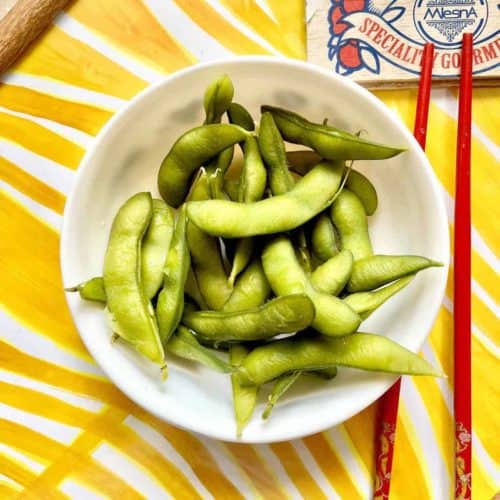
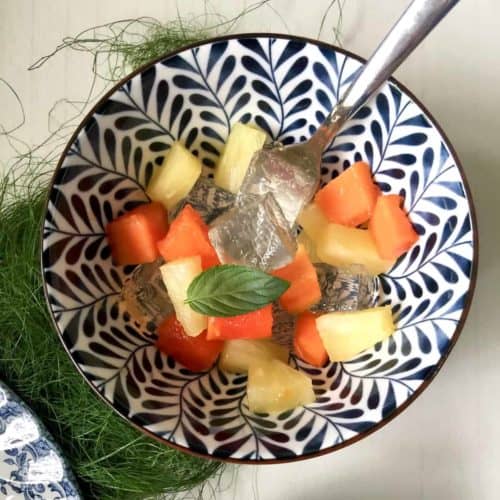
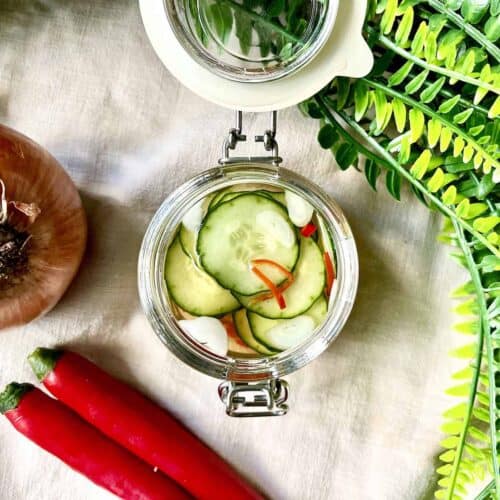
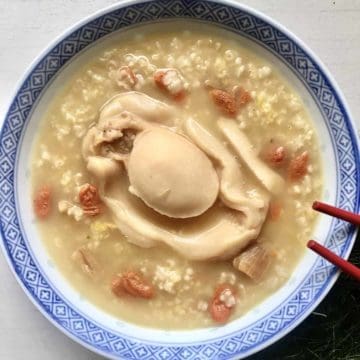
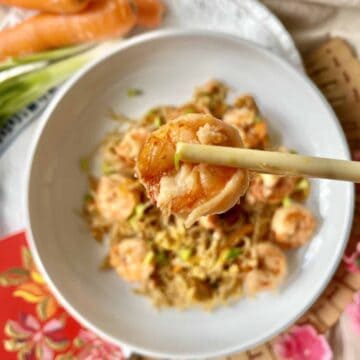
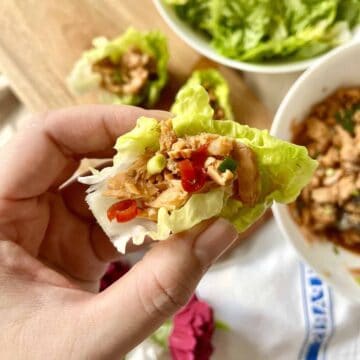
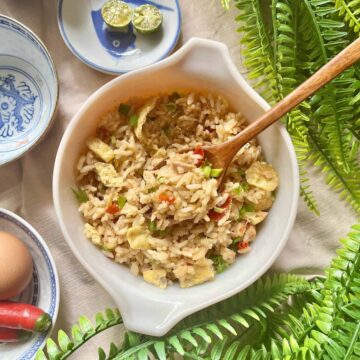
Jenny says
This was so easy and delicious! Can you share a sushi bake recipe with shrimp too please? Thanks!
Zen says
So glad you liked them Jenny, will share a shrimp bake ASAP!